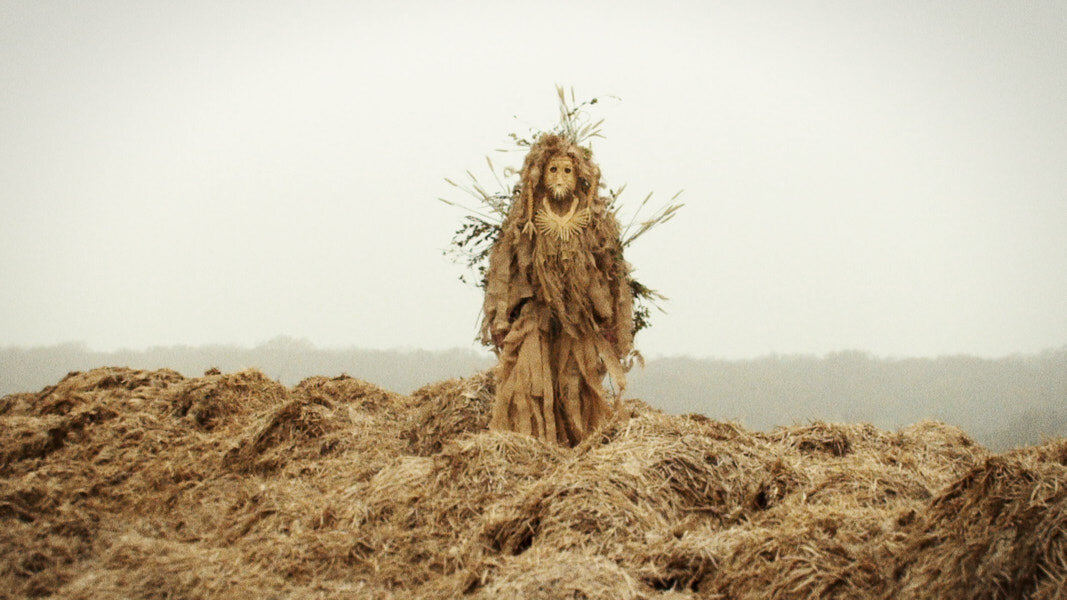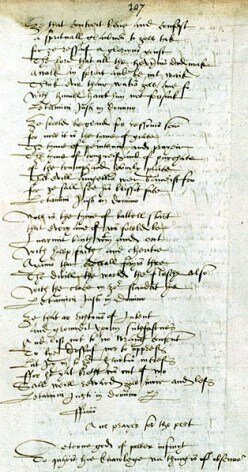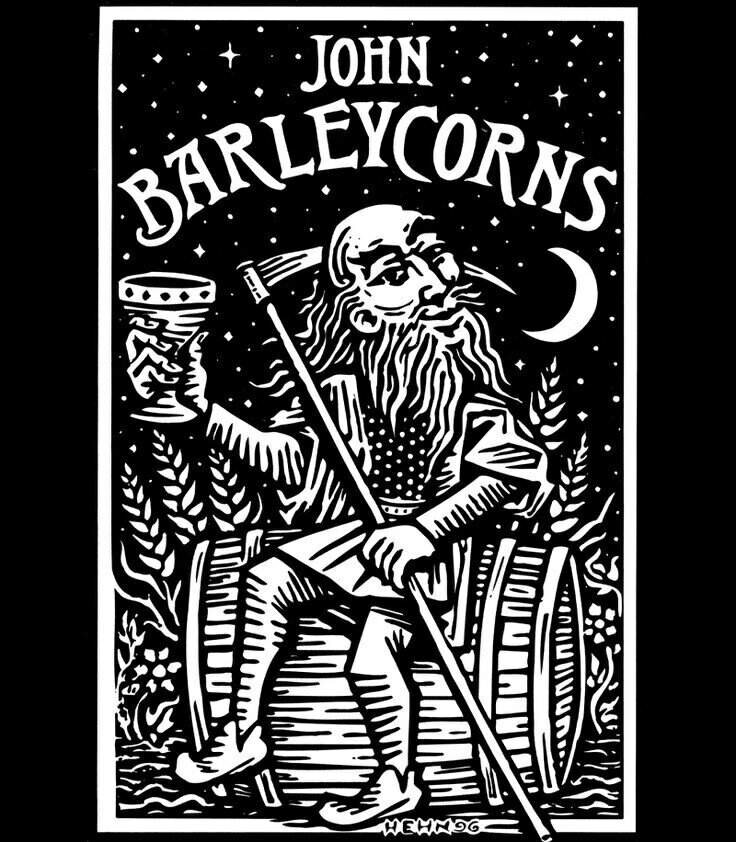Who is John Barleycorn? || Gruesome Origins & Modern Retellings
I was planning on making a post about the different harvest traditions for the Autumn Equinox, but in the middle of doing research for that I came across a character so crazy and fascinating that I felt the need to devote a whole post to him. So today let’s go down the rabbit hole together to explore the strange tale of John Barleycorn and what it might reveal about our Pagan history.
The Autumn Equinox, also known as Mabon, is the second of the three important harvest festivals. Most Pagan harvest festivals embrace the idea of sacrifice, perhaps none more so than Mabon, which is the time when the last sheaf of wheat & barley would be harvested. This notion of Sacrifice is one of the key themes associated with the popular story of John Barleycorn. You may have heard one of the many musical variations of this story or perhaps you're more familiar with the Robert Berns version from 1782.
If you haven’t ever heard this English Folk Song, give it a listen.
Bannatyne Manuscript 1568 CE
The story of John Barleycorn actually has really old origins. There is a Scottish poem with a very similar theme and wording included in the Bannatyne Manuscript of 1568, though it’s likely that John Barleycorn is even older. This is because the Bannatyne Manuscript is a collection of pre-existing works, many coming from the ancient oral tradition. And considering the many pagan themes in the story, it’s definitely possible that the origins lie in Pre-Christian times. Specifically there may even be a link between John Barleycorn and the mythical figure Beowa, which is a figure from Anglo-Saxon paganism whose name means "barley."
Now, the prevailing theory is that the tale of John Barleycorn is a symbolic representation of the crop of barley being harvested each autumn. The song describes the process of preparing the land, sowing the seeds, waiting for the crop to grow, and eventually harvesting. Then the song describes making the products of beer and bread which were key staples of the diet of early agrarian people. For the most part this all makes sense but those of you who have read the poem or listened to the song have probably noticed the really gruesome way that this harvest is worded. For example:
“They laid him out upon the floor,
To work him further woe;
And still, as signs of life appear’d,
They toss’d him to and fro.
They wasted o’er a scorching flame,
The marrow of his bones;
But a miller us’d him worse of all,
For he crush’d him between two stones.
And they hae taen his very heart’s blood,
And drank it round and round;
And still the more and more they drank,
Their joy did more abound.”
Sure, maybe that’s just meant to be a creative interpretation of how to turn barley into beer and perhaps the reason this story has survived so long is in part due to the violent imagery, which makes the story more interesting and memorable. Though perhaps there’s a bit more to the story...
I want to share a theory that I recently found that might have some merit. This theory proposes that the tale of John Barleycorn is more than just a metaphor for the barley harvest and that it in fact contains references to real human sacrifices that occurred in Ancient Britain. I know what you’re thinking - pagan human sacrifice is a big trope often used by others to slander paganism. But hear me out for a second because there’s some really interesting passages in this poem that deserve further inspection.
The poem begins with:
“There were three men come out of the west,
their fortunes for to try,
And these three men made a solemn vow,
John Barleycorn would die”
It’s interesting that we start with 3 men coming out of the West. We’re all familiar with the religious importance of the number three. The Celtic triad & triple spiral are of course famous symbols in Celtic paganism. I also think it’s interesting that these men are coming from the West because in Celtic myths coming from “The West” meant coming from the otherworld or realm of the Fae.
Also, in the tale of John Barleycorn before the the cutting of the barley there is an interesting passage that states:
“They let him stand till midsummerTill he looked both pale and wan,
And little Sir John he growed a long beard
And so became a man.”
Of course the reference to midsummer is interesting from a pagan perspective but I’m even more interested in the “growing a long beard” part. Firstly, I’m not sure how the beard part fits in if this poem is just a metaphor for the barley harvest. Instead, I think it’s possible that it’s referencing the long beards of the druids. The druids believed that our life-force was channeled through the extremities which is why Druid priests would grow their beards and hair long. So perhaps our John Barleycorn is representing a sacrificial priest.
Next in the story we have a death being depicted in the poem, but it’s a three-fold death. The poem states:
“They hired men with the scythes so sharp
To cut him off at the knee,
They rolled him and tied him by the waist,
And served him most barbarously.
They hired men with the sharp pitchforks
Who pricked him to the heart.”
The three-fold death is a really common theme in Cetic and Anglo-Saxon folklore. Even Merlin in the Arthurian legends prophesied a three-fold death for himself which would occur by falling, stabbing, and then drowning.
So already we’ve found references in the passages of John Barleycorn to:
The celtic triad and the Faerie realm in the west
The spiritual tradition of beard growing among the Druids
The importance of the three-fold death in Celtic lore.
So what’s really going on here?
In the famous anthropological book called “The Golden Bough” by Sir James Frazer, he states that the Barley King was personified in ancient ritual practice by a real person. This man was honored as a King during the yearly cycle and when it was harvest time he would be sacrificed and dismembered and his body was dragged through the fields to ensure a fertile harvest for next year.
This reminds me of a particularly gruesome passage in the poem:
“They've wheeled him around and around the field till they've come unto a barn
And here they've kept their solemn word concerning Barleycorn
They've hired men with the crab tree sticks to split his skin from bone.”
If this is just a metaphor for harvesting the barley, then what is the purpose of wheeling him “around and around” the field. Perhaps Sir James Frazer might be right and that this passage could be a reference to the sacrificed individual being dragged through the fields to ensure the fertile harvest.
It’s definitely a pretty disturbing visual and I probably should point out that we don’t really have much historical evidence concerning Pagan religious sacrifice. One of the most popular accounts of pagan human sacrifice comes from Julius Caesar during his conquest of Gaul where he reports to have seen the burning alive of victims in a large wooden effigy, which is now known as a wicker man. Though considering the Celts were his enemy at the time it is possible he exaggerated some details.
So, while it’s likely that some human sacrifice occurred among the Celts and Anglo-Saxons we don’t really know too many details and it’s likely that the violence was probably a bit exaggerated.
So when it comes to our story of John Barleycorn we have our two main theories:
The first theory is that the story of John Barleycorn is just a metaphor of the barley harvest and that any violent wording was just added for extra flair and it doesn’t represent any wider themes. The second theory is that the story of John Barleycorn actually contains references to the practice of religious human sacrifice among the Celtic and the Anglo-Saxon pagans.
So which theory is correct?
In my opinion I think it might be both. I think the main purpose of the story is to be a metaphor for the autumn barley harvest. Though because this story is in fact really old, I think it picked up some Pagan references, stereotypes, and motifs along the way.
But, I’d love to hear what you think the story of John Barleycorn represents. So share your thoughts down below in the comments.
And if you liked this post and would like to support the work I do here and my pagan research, please consider joining my patreon family. For the price of a cup of coffee you get extra content, monthly live chats, and tarot readings.







